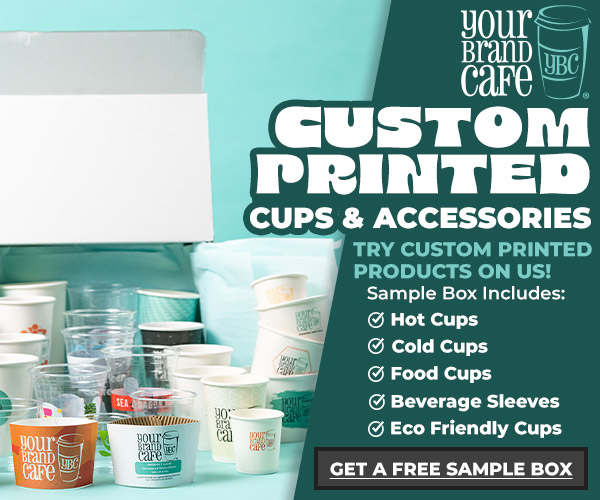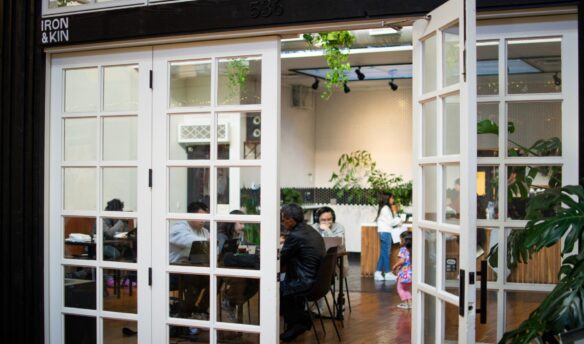[W]alk into any coffeehouse and start counting the number of computerized, plugged-in gadgets permeated through the establishment. There’s a good chance you’ll run out of fingers before you finish. There are the espresso machines, the brewers, sometimes grinders, digital thermometers, and maybe a roaster with enough computing power to fly a drone. Even a shop that pushes back against the tech tide, trading espresso machines with microcontrollers for those with levers, will have a slew of business apps on an iPad somewhere in the shop. And if tea thought it was immune to the gadgetry of coffeehouses, the recent appearance of vacuum-driven, control-panel-operated brewers proved that wrong.
That tech is amazing and has transformed how teahouses and coffee shops craft incredible drinks, but the way they run their business—handling payments, scheduling employees, running loyalty programs, tracking inventory, choosing tunes—has been teched-up just as much as the craziest new brewing system. Here we’ll explore the tech that doesn’t make drinks but makes drinks possible.
POS
There’s no non-brewing piece of technology in a café or teahouse more important than the point of sale system. If that’s not obvious, just imagine (or remember) what would happen if your POS went down. Terrible, right? There’s also no other piece of technology that’s been as transformed by technological advances. For a long time now, these systems have been on the technological cutting edge. Think back to the first time you used a touch screen, it was probably the first POS system you used.
The coffee and tea industries are lucky to have several POS companies either devoted or customized to their needs. Coffee Shop Manager, Selby Soft, and Shop Keep are the industry’s big three. JP’s Coffee and Espresso Bar in Holland, Michigan, uses Coffee Shop Manager. Sherry White, the shop’s operations manager, has used systems that weren’t built for coffeehouses, and the difference is huge. “Because it was designed specifically for the coffee trade,” she says, “the software is set up by people who understand our industry. There’s a logic that eludes other people.”
Beyond a natural flow to punching in orders, beverage-specific systems offer a key feature often missing from other systems: gift card programs. At JP’s, Sherry says, “On any given day ten percent of our sales are redemptions of gift cards.” Many of these gift cards are used by regulars who recharge the cards. The cards that are gifts become a major source of advertising for JP’s. Mike Spence, vice president at Selby Soft, has a pithy explanation of why gift cards matter: “Every time you swipe a gift card, you’re not swiping a credit card. That saves money and it can only be spent at this shop.”
“You need to be able to track everything you’re doing. If you don’t have this data, you can only base decisions on memory and emotion.”
Beyond the employee and costumer experience with a POS, the systems collect and present the data a manager or owner needs to understand how a shop works and spot problems. Robust POS systems, and all those made for beverage vendors are robust, can show, often in real time, cost of goods sold, labor-to-sales ratios, inventory, sales comparisons, and the variances of how much of a product you used compared to how much you should have used. That’s just for starters. “You need to be able to track everything you’re doing,” Mike says. “If you don’t have this data, you can only base decisions on memory and emotion.”
It almost goes without saying that Square changed this part of commerce for small businesses. Maybe it’s more accurate to say that the iPad did. Suddenly the competition for POS dollars exploded, and the options for owners expanded massively. Apps like When I Work, a scheduling program, breakdown POS into pieces, allowing an à la carte approach to a shop’s system.
The main advice from established shops on choosing a system boils down to the axiom, “Know thyself.” Understanding what you need from a POS is the first step toward choosing one. Square is a great system for processing credit cards and collecting some data on sales, but it’s not currently built for high volume or fine grain data or gift cards. Selby Soft allows a bustling café or drive-through to add an order screen that can line up multiple orders and alert staff when the baristas need help. Each system is a perfect fit, if the right shop adopts it.
Music Players
Quick legal quiz: Is your shop bigger than 3,750 square feet? Do you have more than five speakers in your shop? Are four speakers in one room? Did you answer yes to any of these questions? You did! Oh, no! Turn off your music, you’re a lawbreaker!

The tunes playing in the background at a café (and sometimes the foreground) are considered a commercial use of music, which the fine print on your CDs, vinyl, and the user agreement for the music player expressly forbids. So if you have a shop bigger than 3,750 square feet or use six speakers you have to procure licenses to play your music. If you just have to play vinyl, it’s possible to purchase those licenses from the various artist and label groups. For the less fidelity-manic out there, there are options.
Before music streaming took off, the main option for licensed music was one of the providers of packaged playlists. These services had several problems, mostly revolving around terrible music and a lack of personalization. Now, though, shops can use certain streaming services to play music legally.
Pandora, that venerable tech grandpa, provides licensed music through DMX. Unlike the regular Pandora experience, a commercial user must buy the DMX player, which resembles a stereo amp and plugs into a sound system and the Internet. From there, the user starts and personalizes stations. Why a chunky piece of hardware is required for this, rather than just an account name and password, doesn’t make much sense.
A better, twenty-first century solution may arrive soon, once it can ship out of Sweden. There, a company called Soundtrack Your Brand teamed up with Spotify to create a program within Spotify that allows businesses to create playlists and schedule them throughout the week. Up to five locations can be managed through one account.
We’ll let the Copenhagen cafés and teahouses report how well this works. In the meantime, you should flip that Neil Diamond vinyl.
Loyalty Apps
The days of crumpled, ripped, laundered, and lost paper loyalty cards are numbered. As smartphones and tablets proliferated, so did apps offering companies easy-to-manage loyalty programs. Land of a Thousand Hills Coffee House in Roswell, Georgia, has used an app called Belly for a couple of years. Jono Moehlig, the shop’s manager, says, “It’s incredibly easy to get people to sign up because Belly is already in the Atlanta area.” And that’s a key to these programs. Many customers won’t want yet another app with another login name and password clogging up their phone. Setting aside price and features, the app most of your customers already use should factor into your decision.
Jono offers a free cup of coffee, sure, but customers can also rack up points for roastery tours or to make their own drink.
Unlike a punch card that offers one free thing (a latte) after so many purchases (ten), these apps allow a variety of goodies and multiple ways to accumulate virtual punches. Jono offers a free cup of coffee, sure, but customers can also rack up points for roastery tours or to make their own drink. With Belly, points are earned by visits, not by dollars spent. Other programs, like Perka, flip that. Then there are community loyalty programs. These get a bit more complicated. The Supportland program (one guess where it is) awards points based on sales at any of the network’s shops. Those points can be redeemed anywhere, even a place the customer never patronized before.
While these programs are designed mainly with smartphone owners in mind, most of the programs supply cards printed with QR codes. At Thousand Hills, customers scan the QR code on their card or smartphone on an outward-facing iPad, the barista doesn’t have to be involved. Other programs do the same thing, but with the barista scanning the code behind the counter. With Perka, a customer simply introduces herself to the barista who finds the person on the shop’s Perka app, which knows what users are nearby. Which is neat, and creepy.
Loyalty apps can even feed off our need for compulsive, Candy Crush-style collection. Right after he started at the café Jono says, “Someone tweeted that they came to the shop just to get the points.”
E-mail hadn’t made this list until Sherry White at JP’s Coffee and Espresso Bar brought it up. It’s almost hard to think of it as technology, it’s so commonplace and old. JP’s has a large staff and a brain-spinning schedule, and critical tasks like handing out paystubs or explaining menu changes can’t be done in-person for every employee. To manage this, every employee has a JP’s e-mail address and that’s where paystubs, café announcements, and schedules go. E-mail may be low-tech at this point, but it’s powerful for organization.
Wi-Fi Managers
The blessing and curse of Wi-Fi continues to plague coffeehouses and teashops. There’s nothing more complementary than a café and laptop and there’s no eyesore bigger than a shop filled with laptops and empty cups. That no single solution or policy has arisen for this problem is surprising considering its perennial nature. Providing limited-time passwords with purchases may become the standard in the industries; unfortunately only a few companies offer easy ways to implement this straightforward fix.
WEBbeams has staked out a coffee shop niche by partnering with several POS makers to integrate their software into the system rather than adding another piece of equipment. The program allows the shop to provide individual passwords that timeout after a set duration. The system allows a degree of customization, including multiple timeframes, so the balance between access and profitability can be altered for each shop.
—Cory Eldridge is the editor at Fresh Cup.



















